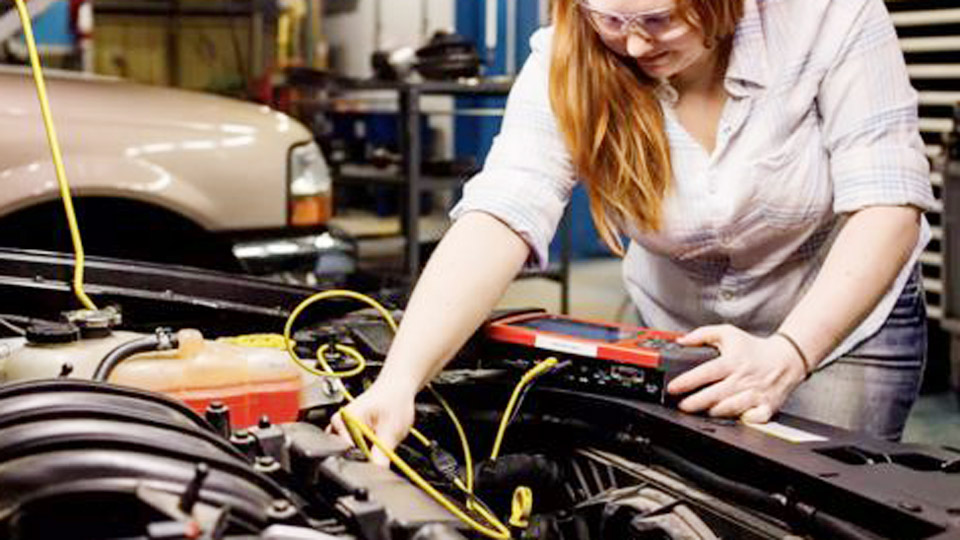How to Become an Automotive Technician in Ontario?
I’ve always loved cars—tinkering with my old pickup in my driveway sparked a passion that led me to explore a career as an automotive technician. When I decided to pursue this path in Ontario, I discovered it’s a rewarding but structured journey requiring education, hands-on training, and certification. Becoming an automotive technician in Ontario means mastering skills to diagnose and repair vehicles, from engines to electronics, while meeting the province’s strict standards.

Photo by confederationcollege
I’ve navigated this process myself, spending time in shops and classrooms, and I’m excited to share what I’ve learned. If you’re a car enthusiast or just curious about a stable career, let’s walk through the steps to become an automotive technician in Ontario, along with tips to succeed.
What Is an Automotive Technician?
An automotive technician, also called an automotive service technician, is a skilled professional who fixes cars, trucks, and sometimes motorcycles. I think of them as car doctors—they diagnose issues, repair parts, and keep vehicles running safely. I started by changing oil in my sedan, but technicians handle complex tasks like rebuilding transmissions or troubleshooting electrical systems.
In Ontario, this is a regulated trade, meaning you need proper training and certification to work legally. I learned this when I tried to get a shop job without credentials—it didn’t go far! Technicians work in dealerships, repair shops, or even as entrepreneurs, and their skills are always in demand.
Why Choose a Career as an Automotive Technician?
I chose this path because I love problem-solving and working with my hands. Cars are everywhere, so the job is stable—people always need repairs. I’ve seen shops stay busy even during tough times. In Ontario, technicians earn $40,000-$80,000 a year, depending on experience, and top pros make more.
I was drawn to the variety, too—no two days are the same. One day I’m fixing brakes, the next I’m diagnosing a check engine light. Plus, modern cars have cool tech, like hybrid systems, which keeps the job exciting. If you’re curious and love cars, it’s a career that rewards hard work.
Understanding Ontario’s Requirements
Ontario regulates automotive technicians under the Building Opportunities in the Skilled Trades Act, 2021. I found out early that it’s a compulsory trade—you can’t work without a Registered Training Agreement or Certificate of Qualification. This ensures high standards but means you need to follow a clear path. I was intimidated at first, but breaking it down made it manageable.
You’ll need education, an apprenticeship, and a certification exam to become a licensed technician. I’ll explain each step, but know that Ontario’s system is designed to make you a skilled pro who can work anywhere in Canada.
Step-by-Step Guide to Becoming an Automotive Technician
I’ve been through this process, and it’s straightforward if you stay focused. Here’s how I became an automotive technician in Ontario, step by step.
Step 1: Complete High School Education
You need a high school diploma or equivalent to start. I graduated with my Ontario Secondary School Diploma (OSSD), focusing on math, science, and shop classes. These helped me understand engines and electronics. Grade 12 English is often required for college programs, so I made sure to pass it.
If you’re still in school, join auto clubs or take co-op placements—I did a co-op at a local shop and learned basic repairs. If you don’t have a diploma, you can take a General Education Development (GED) test or upgrade through adult education. I helped a friend do this, and he got into a program fast.
Step 2: Enroll in a Pre-Apprenticeship or College Program
I wanted a head start, so I enrolled in a two-year Automotive Service Technician program at Centennial College. Ontario colleges like Humber, Fanshawe, and Mohawk offer similar programs. They teach you engines, brakes, electrical systems, and diagnostics in classrooms and shops. I loved the hands-on labs—fixing real cars felt like a puzzle.
Some programs, like mine, count toward your apprenticeship’s in-school hours, saving time later. Pre-apprenticeship programs are another option—they’re often free, funded by the government, and last about a year. I met a guy in a pre-apprenticeship who landed a shop job right after. These programs build skills and make you stand out to employers.
Step 3: Find an Apprenticeship
The heart of becoming a technician is the apprenticeship. I registered with Skilled Trades Ontario and found a shop willing to hire me as an apprentice. You need 7,220 hours—about four years—of work experience, including 6,500 hours on the job and 720 hours in school. I started at a small garage, doing oil changes and tire rotations while learning from a journeyperson.
Dealerships, like Ford or Toyota, also offer apprenticeships, and some colleges help you find one. I applied to shops like Mr. Lube to get my foot in the door—it’s easier to start there during busy seasons. You’ll need a Registered Training Agreement (RTA) with your employer, which I filed through Skilled Trades Ontario’s portal.
Step 4: Complete In-School Training
During my apprenticeship, I attended 720 hours of in-school training, split into three levels over four years. I went to Mohawk College for eight-week blocks, learning advanced topics like transmissions and hybrid systems. The province covers most costs, and I was eligible for Employment Insurance (EI) during school.
I found the classes intense but practical—we worked on real vehicles and used diagnostic tools. If you’re in a college program, you might complete some levels early, like I did at Centennial. I studied hard, knowing this training prepared me for the certification exam.
Step 5: Pass the Certification Exam
After my apprenticeship, I took the Certificate of Qualification (C of Q) exam for Automotive Service Technician (310S). It’s a 125-question multiple-choice test covering engines, brakes, electrical systems, and safety. I was nervous, but studying my apprenticeship notes and taking practice tests helped.
I used free resources from the Red Seal website, which sets national standards. Passing gave me a Certificate of Qualification, letting me work legally in Ontario. I celebrated that day—it felt like earning my mechanic badge! The exam costs about $150, and you can retake it if needed, but I passed on my first try with preparation.
Step 6: Consider Red Seal Certification
I wanted flexibility, so I pursued Red Seal certification after my C of Q. This national endorsement lets you work anywhere in Canada without extra licensing. I studied for the Red Seal exam, which is similar to the C of Q but tests interprovincial standards.
I passed after a month of review, and it opened doors to jobs in Alberta and B.C. It’s optional, but I recommend it if you might move or want to stand out. I’ve seen Red Seal techs get hired faster at big dealerships.
Step 7: Keep Learning and Specializing
Cars keep evolving, so I stay current with training. I took courses on electric vehicles (EVs) and earned an Ozone Depletion Prevention certificate for handling refrigerants. Some techs specialize in transmissions or brakes—Ontario requires separate certifications for those.
I’m eyeing a collision repair certification to boost my skills. Workshops at TIRECRAFT and dealerships keep me sharp, and I read trade magazines to learn about new tech. Continuous learning has made me a better tech and increased my pay.
Essential Skills for Automotive Technicians
I’ve learned that skills matter as much as credentials. Here’s what I honed to succeed:
- Problem-Solving: Diagnosing a car’s issue is like solving a mystery. I once traced a misfire to a bad spark plug using logic.
- Mechanical Aptitude: You need to understand how parts work. I practiced disassembling engines in school.
- Attention to Detail: Small mistakes can cause big problems. I double-check torque settings on bolts.
- Tech Savvy: Modern cars use computers. I learned to use diagnostic scanners early.
- Physical Stamina: The job is physical—lifting tires or bending over engines. I stay fit to handle it.
- Customer Service: Explaining repairs builds trust. I talk clearly to customers about their car’s needs.
I worked on these skills in shops and classes, and they’ve made me a confident tech.
Where to Find Apprenticeship Opportunities
Finding an apprenticeship was my biggest challenge. I started by applying to local shops like Jiffy Lube and Canadian Tire—they’re often hiring entry-level help. Dealerships post apprenticeship roles on their websites, and I checked Ford and GM’s job boards.
Networking helped, too—I met my first employer at a car show. TIRECRAFT and college career fairs are great places to connect with shops. I also used Skilled Trades Ontario’s portal to search for employers. Be persistent—I applied to 10 shops before landing my first gig.
Tools and Equipment You’ll Need
Technicians often buy their own tools, which surprised me at first. I started with a basic set costing $500, including wrenches, sockets, and screwdrivers. Over time, I added a diagnostic scanner and specialty tools for brakes.
Shops provide big equipment, like lifts, but I invested $2,000 in my toolbox by year two. I bought quality brands like Snap-On and Craftsman—they last longer. Some employers offer tool allowances, so I asked about that when interviewing. Start small and build your collection as you earn.
Costs and Financial Support
The journey isn’t cheap, but support exists. My college program cost $5,000-$7,000 for two years, but I got student loans through OSAP. Apprenticeships are paid, and I earned $15-$20/hour as a beginner. In-school training is mostly free, and EI covered my living costs during classes.
I applied for grants through the Ontario government, like the Apprenticeship Completion Grant ($2,000). TIRECRAFT and some shops offer signing bonuses or tool subsidies. I budgeted carefully and worked part-time at a lube shop to cover early costs.
Common Challenges and How to Overcome Them
I hit a few bumps on my journey. Here’s what I faced and how I dealt with them:
- Finding an Apprenticeship: Shops were picky. I gained experience at a quick-lube shop first, which made me more hirable.
- Long Hours: Apprenticeships are demanding. I paced myself and took breaks to avoid burnout.
- Complex Tech: Modern cars are tricky. I studied online tutorials and asked my mentor for help.
- Exam Stress: The C of Q test was daunting. I joined a study group and practiced daily.
- Tool Costs: Tools are pricey. I bought used ones from retiring techs to save money.
Patience and persistence got me through, and I’m stronger for it.
Career Paths and Opportunities
Once certified, the world opens up. I started at a dealership, earning $25/hour, and now work at an independent shop with better hours. You can specialize in areas like diesel engines or electric vehicles—I’m considering EVs for the future.
Some techs become service advisors or open their own shops. I know a guy who started a garage after 10 years and loves being his own boss. Others work in fleet maintenance or teach at colleges. I love the flexibility—there’s always a new path to explore.
Training Programs in Ontario
Here’s a table of top Ontario colleges for automotive technician training, based on my research and experience:
| College | Program | Why I Like It |
|---|---|---|
| Centennial College | Automotive Service Technician (310S) | Offers co-op and EV courses, credits toward apprenticeship levels 1 and 2. |
| Humber College | Motive Power Technician | Modern labs, strong industry connections, hands-on focus. |
| Fanshawe College | Motive Power Technician – Automotive | Highly rated, includes business skills, great for starting your own shop. |
| Mohawk College | Automotive Service Technician – 310S | Affordable, flexible schedules, Red Seal prep included. |
| Durham College | Automotive Technician – Service & Mgmt | Co-op option, teaches business skills, fast-tracks apprenticeship. |
These programs are respected and set you up for success.
Tips for Success
I’ve picked up tricks to thrive in this career:
- Network Early: Talk to shop owners at car shows or job fairs. I met my mentor this way.
- Stay Curious: Ask questions on the job. I learned hybrid systems by shadowing a senior tech.
- Keep Tools Organized: A messy toolbox slows you down. I use foam inserts to stay tidy.
- Learn Tech: Master diagnostic tools—they’re the future. I practiced with a cheap scanner at home.
- Be Professional: Show up on time and communicate well. My boss promoted me for reliability.
These habits made me stand out and grow faster.
Women and Diversity in the Trade
I’ve noticed the trade is mostly male, but that’s changing. I met a female tech at Fanshawe who’s killing it at a dealership. Shops want skilled workers, regardless of gender. Ontario’s government offers programs like the Women in Skilled Trades Initiative, which helped a friend with training costs.
I encourage anyone passionate about cars to jump in—diversity makes the industry stronger. My shop hired a new tech from Jamaica, and his fresh perspective improved our work.
Eco-Friendly Practices in the Trade
I care about the planet, so I love that technicians can go green. I recycle oil and batteries at my shop—they take them free. I use eco-friendly fluids when possible and learn about EVs to support clean tech.
Proper maintenance, like tuning engines, cuts emissions. I also bike to work sometimes to save fuel. These small steps make a difference, and customers appreciate it when I explain how repairs help the environment.
Maintaining Your Certification
Your Certificate of Qualification needs renewal to stay valid. I renew mine through Skilled Trades Ontario, paying a small fee every few years. I also take refresher courses to stay sharp—my shop paid for an EV workshop last year.
Keeping your info on the Skilled Trades Ontario Public Register is required, too. I check mine online to ensure it’s current. Staying certified keeps you legal and employable.
Conclusion
Becoming an automotive technician in Ontario is a journey of hard work, learning, and rewards. I went from tinkering in my driveway to earning a solid living fixing cars I love. From high school to college, apprenticeships to certification, each step builds skills that keep vehicles safe and drivers happy.
I’ve faced challenges, but the thrill of solving a tough diagnosis or seeing a customer’s smile makes it worth it. If you’re curious, persistent, and love cars, this career is for you. Grab your tools, find a shop, and start your path today—you’ll be revving up a bright future in no time!
FAQs
Do I need a high school diploma to become an automotive technician in Ontario?
Yes, you need a diploma or GED. I got my OSSD and took shop classes to prepare.
How long does it take to become a certified technician in Ontario?
About four years, including an apprenticeship. I finished in four by starting with a college program.
Can I start working in a shop without experience?
Yes, try quick-lube shops like Mr. Lube. I started there to gain skills before my apprenticeship.
How much does an automotive technician earn in Ontario?
I earn $25/hour now, but new techs start at $15-$20. Experienced pros can make $80,000 a year.
Is the certification exam hard?
It’s tough but doable. I passed by studying my notes and using Red Seal practice tests.
Can I work in other provinces with Ontario’s certification?
Yes, with Red Seal certification. I got mine to have options to work across Canada.

David Peterson, the chief editor of sparepartscare. I am an automobile engineer and assign to an local firm with much experience in automobile equipment. During the time, most of my experience is related to the Industry of cars parts. I learned about the thing, when working with experienced inspectors, one must be as good as the inspector, or better, with knowledge of the project as well as the practical aspects of automobile industry.






